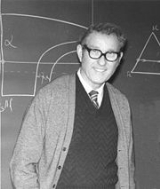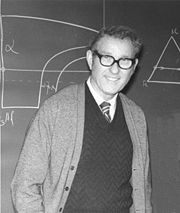
William E. Wallace
Encyclopedia

Physical chemistry
Physical chemistry is the study of macroscopic, atomic, subatomic, and particulate phenomena in chemical systems in terms of physical laws and concepts...
whose career coincided with the golden age of chemistry
Chemistry
Chemistry is the science of matter, especially its chemical reactions, but also its composition, structure and properties. Chemistry is concerned with atoms and their interactions with other atoms, and particularly with the properties of chemical bonds....
. He received a bachelor's degree in chemistry
Chemistry
Chemistry is the science of matter, especially its chemical reactions, but also its composition, structure and properties. Chemistry is concerned with atoms and their interactions with other atoms, and particularly with the properties of chemical bonds....
from Mississippi College
Mississippi College
Mississippi College, also known as MC, is a private, Christian university located in Clinton, Mississippi. Mississippi College comprises the main campus in Clinton, as well as satellite campuses in Brandon and Madison, Mississippi, and the Mississippi College School of Law in Jackson...
in 1936, and a Ph. D. in Physical Chemistry
Physical chemistry
Physical chemistry is the study of macroscopic, atomic, subatomic, and particulate phenomena in chemical systems in terms of physical laws and concepts...
from the University of Pittsburgh
University of Pittsburgh
The University of Pittsburgh, commonly referred to as Pitt, is a state-related research university located in Pittsburgh, Pennsylvania, United States. Founded as Pittsburgh Academy in 1787 on what was then the American frontier, Pitt is one of the oldest continuously chartered institutions of...
in 1941. As many prominent scientists of his era, he worked on the Manhattan Project
Manhattan Project
The Manhattan Project was a research and development program, led by the United States with participation from the United Kingdom and Canada, that produced the first atomic bomb during World War II. From 1942 to 1946, the project was under the direction of Major General Leslie Groves of the US Army...
during the Second World War, but he returned to the University of Pittsburgh
University of Pittsburgh
The University of Pittsburgh, commonly referred to as Pitt, is a state-related research university located in Pittsburgh, Pennsylvania, United States. Founded as Pittsburgh Academy in 1787 on what was then the American frontier, Pitt is one of the oldest continuously chartered institutions of...
as a faculty member in 1945. He remained there for the rest of his career, eventually becoming the fourth chairman of the chemistry department from 1963–1977, and then a Distinguished Service Professor Emeritus. He formally retired from the university in 1983, but his research continued. He was associated with the Mellon Institute of Industrial Research
Mellon Institute of Industrial Research
Mellon Institute of Industrial Research, founded in 1913 by Andrew W. Mellon and Richard B. Mellon, merged with the Carnegie Institute of Technology in 1967 to form Carnegie Mellon University in Pittsburgh, Pennsylvania, United States...
, and he started a research corporation (Advanced Materials Corporation) in the Oakland
Oakland (Pittsburgh)
Oakland is the academic, cultural, and healthcare center of Pittsburgh and is Pennsylvania's third largest "Downtown". Only Center City Philadelphia and Downtown Pittsburgh can claim more economic and social activity than Oakland...
section of Pittsburgh
Pittsburgh, Pennsylvania
Pittsburgh is the second-largest city in the US Commonwealth of Pennsylvania and the county seat of Allegheny County. Regionally, it anchors the largest urban area of Appalachia and the Ohio River Valley, and nationally, it is the 22nd-largest urban area in the United States...
with offices on an upper floor of a building on North Bellefield Avenue, midway between the University of Pittsburgh
University of Pittsburgh
The University of Pittsburgh, commonly referred to as Pitt, is a state-related research university located in Pittsburgh, Pennsylvania, United States. Founded as Pittsburgh Academy in 1787 on what was then the American frontier, Pitt is one of the oldest continuously chartered institutions of...
and Carnegie Mellon University
Carnegie Mellon University
Carnegie Mellon University is a private research university in Pittsburgh, Pennsylvania, United States....
. He was accustomed to taking the stairs to his office, sometimes two at a time, while his younger colleagues struggled to keep up with him.
As chairman of the University of Pittsburgh Chemistry Department, he championed the construction of a new, high-rise chemistry building (Johnstone, Newcomer and Valentour, Architects) that was dedicated in November, 1974, and the move of the department from its former location in Alumni Hall. Wallace's research spanned many fields, including measurements of low temperature specific heat, investigation of magnetic
Magnetism
Magnetism is a property of materials that respond at an atomic or subatomic level to an applied magnetic field. Ferromagnetism is the strongest and most familiar type of magnetism. It is responsible for the behavior of permanent magnets, which produce their own persistent magnetic fields, as well...
and superconducting materials
Superconductivity
Superconductivity is a phenomenon of exactly zero electrical resistance occurring in certain materials below a characteristic temperature. It was discovered by Heike Kamerlingh Onnes on April 8, 1911 in Leiden. Like ferromagnetism and atomic spectral lines, superconductivity is a quantum...
, and metal hydrides. The later are useful as hydrogen storage materials
Hydrogen storage
Hydrogen storage describes the methods for storing H2 for subsequent use. The methods span many approaches, including high pressures, cryogenics, and chemical compounds that reversibly release H2 upon heating...
. A commonality of much of this research was low temperature
Cryogenics
In physics, cryogenics is the study of the production of very low temperature and the behavior of materials at those temperatures. A person who studies elements under extremely cold temperature is called a cryogenicist. Rather than the relative temperature scales of Celsius and Fahrenheit,...
. Liquid helium
Liquid helium
Helium exists in liquid form only at extremely low temperatures. The boiling point and critical point depend on the isotope of the helium; see the table below for values. The density of liquid helium-4 at its boiling point and 1 atmosphere is approximately 0.125 g/mL Helium-4 was first liquefied...
was used in great quantity, and one room on the ground floor of the new chemistry building was equipped to recover helium gas from experiments and re-liquefy it.
Wallace's main scientific interest was the synthesis and characterization of intermetallic compounds
Intermetallics
Intermetallics or intermetallic compounds is a term that is used in a number of different ways. Most commonly it refers to solid-state phases involving metals. There is a "research definition" adhered to generally in scientific publications, and a wider "common use" term...
of the Rare Earths
Rare earth element
As defined by IUPAC, rare earth elements or rare earth metals are a set of seventeen chemical elements in the periodic table, specifically the fifteen lanthanides plus scandium and yttrium...
, which include the Lanthanide elements
Lanthanide
The lanthanide or lanthanoid series comprises the fifteen metallic chemical elements with atomic numbers 57 through 71, from lanthanum through lutetium...
of the periodic table
Periodic table
The periodic table of the chemical elements is a tabular display of the 118 known chemical elements organized by selected properties of their atomic structures. Elements are presented by increasing atomic number, the number of protons in an atom's atomic nucleus...
. For this research he assembled a huge team of graduate students and post doctoral associates from many countries, including Argentina
Argentina
Argentina , officially the Argentine Republic , is the second largest country in South America by land area, after Brazil. It is constituted as a federation of 23 provinces and an autonomous city, Buenos Aires...
, Egypt
Egypt
Egypt , officially the Arab Republic of Egypt, Arabic: , is a country mainly in North Africa, with the Sinai Peninsula forming a land bridge in Southwest Asia. Egypt is thus a transcontinental country, and a major power in Africa, the Mediterranean Basin, the Middle East and the Muslim world...
, India
India
India , officially the Republic of India , is a country in South Asia. It is the seventh-largest country by geographical area, the second-most populous country with over 1.2 billion people, and the most populous democracy in the world...
, Japan
Japan
Japan is an island nation in East Asia. Located in the Pacific Ocean, it lies to the east of the Sea of Japan, China, North Korea, South Korea and Russia, stretching from the Sea of Okhotsk in the north to the East China Sea and Taiwan in the south...
, Romania
Romania
Romania is a country located at the crossroads of Central and Southeastern Europe, on the Lower Danube, within and outside the Carpathian arch, bordering on the Black Sea...
, Russia
Russia
Russia or , officially known as both Russia and the Russian Federation , is a country in northern Eurasia. It is a federal semi-presidential republic, comprising 83 federal subjects...
, and China
Republic of China
The Republic of China , commonly known as Taiwan , is a unitary sovereign state located in East Asia. Originally based in mainland China, the Republic of China currently governs the island of Taiwan , which forms over 99% of its current territory, as well as Penghu, Kinmen, Matsu and other minor...
. He was the author of Rare Earth Intermetallics (Academic Press
Academic Press
Academic Press is an academic book publisher. Originally independent, it was acquired by Harcourt, Brace & World in 1969. Reed Elsevier bought Harcourt in 2000, and Academic Press is now an imprint of Elsevier....
, 1973). He is credited, along with scientists from Bell Laboratories (among whom was Jack Wernick), with the discovery of the powerful rare earth permanent magnets
Rare-earth magnet
Rare-earth magnets are strong permanent magnets made from alloys of rare earth elements. Developed in the 1970s and 80s, rare-earth magnets are the strongest type of permanent magnets made and have significant performance advantages over ferrite or alnico magnets...
that are used extensively in permanent magnet motors
Electric motor
An electric motor converts electrical energy into mechanical energy.Most electric motors operate through the interaction of magnetic fields and current-carrying conductors to generate force...
today.
Ed Wallace succumbed to Parkinson's Disease
Parkinson's disease
Parkinson's disease is a degenerative disorder of the central nervous system...
on October 28, 2004. His close associate, Raymond S. Craig, also a professor in the depatartment, died of prostate cancer
Prostate cancer
Prostate cancer is a form of cancer that develops in the prostate, a gland in the male reproductive system. Most prostate cancers are slow growing; however, there are cases of aggressive prostate cancers. The cancer cells may metastasize from the prostate to other parts of the body, particularly...
on June 30, 2006.

